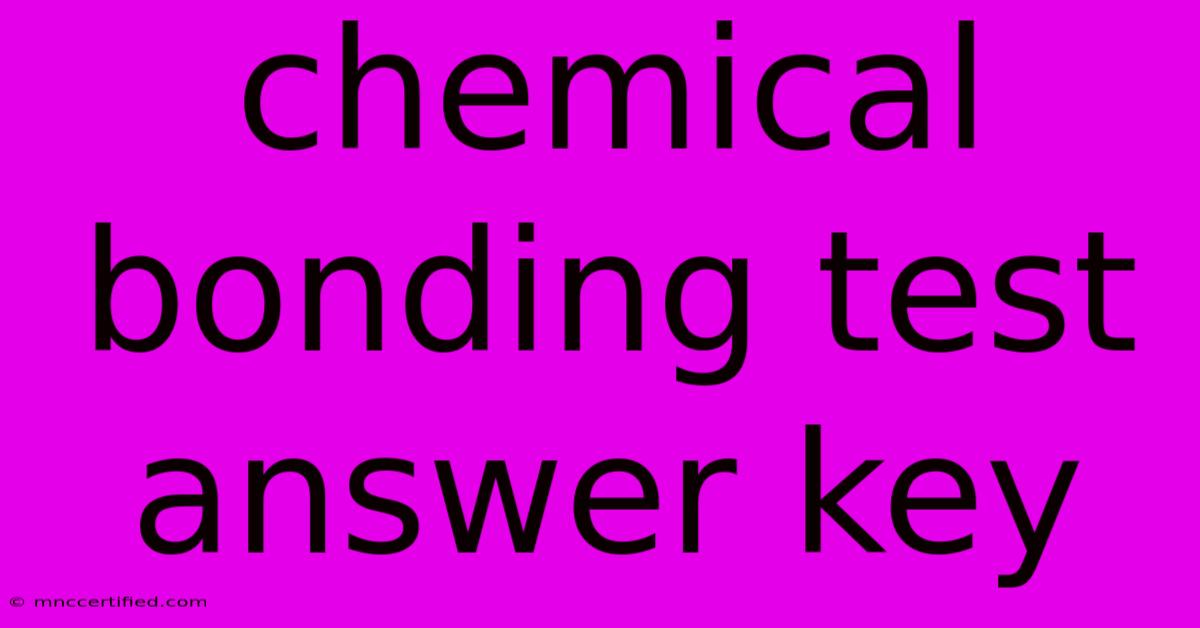Chemical Bonding Test Answer Key

Table of Contents
Chemical Bonding Test Answer Key: A Comprehensive Guide
Finding a reliable answer key for a chemical bonding test can be tricky. This comprehensive guide will not only provide you with sample answers but also equip you with the knowledge to understand why those answers are correct. Mastering chemical bonding requires understanding the underlying principles, not just memorizing facts. We'll cover key concepts and provide tips to improve your understanding and test-taking skills.
Understanding Chemical Bonding: A Quick Recap
Before diving into sample answers, let's refresh our understanding of the fundamental types of chemical bonds:
-
Ionic Bonds: These bonds form through the electrostatic attraction between oppositely charged ions. A metal atom loses electrons to become a positively charged cation, while a nonmetal atom gains these electrons to become a negatively charged anion. Think of NaCl (sodium chloride) – sodium loses an electron, chlorine gains it, creating a strong ionic bond.
-
Covalent Bonds: These bonds involve the sharing of electrons between atoms. Typically, this occurs between nonmetal atoms. The shared electrons create a stable electron configuration for both atoms. Water (H₂O) is a classic example of covalent bonding.
-
Metallic Bonds: These bonds are found in metals. The valence electrons are delocalized, meaning they are not associated with any particular atom but are free to move throughout the metallic structure. This accounts for the properties of metals like conductivity and malleability.
Sample Chemical Bonding Test Questions and Answers
Here are some example questions covering different aspects of chemical bonding, along with detailed explanations:
1. Which type of bond is formed between a metal and a nonmetal?
(a) Covalent bond (b) Ionic bond (c) Metallic bond (d) Hydrogen bond
Answer: (b) Ionic bond
Explanation: Metals tend to lose electrons, forming positive ions, while nonmetals gain electrons, forming negative ions. The electrostatic attraction between these oppositely charged ions results in an ionic bond.
2. What is the primary force holding atoms together in a covalent bond?
(a) Electrostatic attraction between ions (b) Sharing of electrons (c) Delocalized electrons (d) Hydrogen bonding
Answer: (b) Sharing of electrons
Explanation: Covalent bonds are formed by the mutual sharing of electrons between atoms, leading to a stable electron configuration for each atom involved.
3. Which of the following molecules exhibits primarily covalent bonding?
(a) NaCl (b) MgO (c) CH₄ (Methane) (d) KCl
Answer: (c) CH₄ (Methane)
Explanation: Methane is a molecule composed entirely of nonmetals (carbon and hydrogen). Nonmetals tend to form covalent bonds by sharing electrons. NaCl, MgO, and KCl are all ionic compounds.
4. Describe the bonding in a metal like copper.
Answer: Copper exhibits metallic bonding. The valence electrons in copper are delocalized, meaning they are free to move throughout the metallic structure. This electron sea is responsible for copper's electrical and thermal conductivity, as well as its malleability and ductility.
5. Explain the difference between polar and nonpolar covalent bonds.
Answer: In a polar covalent bond, the electrons are shared unequally between the atoms due to a difference in electronegativity. This creates a partial positive charge (δ+) on one atom and a partial negative charge (δ-) on the other. In a nonpolar covalent bond, the electrons are shared equally between atoms of similar electronegativity.
Improving Your Understanding and Test Performance
To ace your chemical bonding test, focus on these strategies:
- Master the Definitions: Understand the core concepts of ionic, covalent, and metallic bonds.
- Practice, Practice, Practice: Work through numerous practice problems to solidify your understanding.
- Visual Aids: Utilize diagrams and models to visualize the structure of molecules and the nature of bonding.
- Seek Clarification: Don't hesitate to ask your teacher or tutor for help if you're struggling with any concepts.
This guide provides a foundation for understanding chemical bonding. Remember, consistent effort and a clear understanding of the underlying principles are key to success. Good luck with your test!

Thank you for visiting our website wich cover about Chemical Bonding Test Answer Key. We hope the information provided has been useful to you. Feel free to contact us if you have any questions or need further assistance. See you next time and dont miss to bookmark.
Featured Posts
-
Health Insurance Broker Plano Tx
Nov 21, 2024
-
Auto Dialer For Insurance Agents
Nov 21, 2024
-
Certificate Of Insurance Florida
Nov 21, 2024
-
Rhinoplasty Covered By Insurance
Nov 21, 2024
-
Kd Tp Swap Get Started In Crypto
Nov 21, 2024